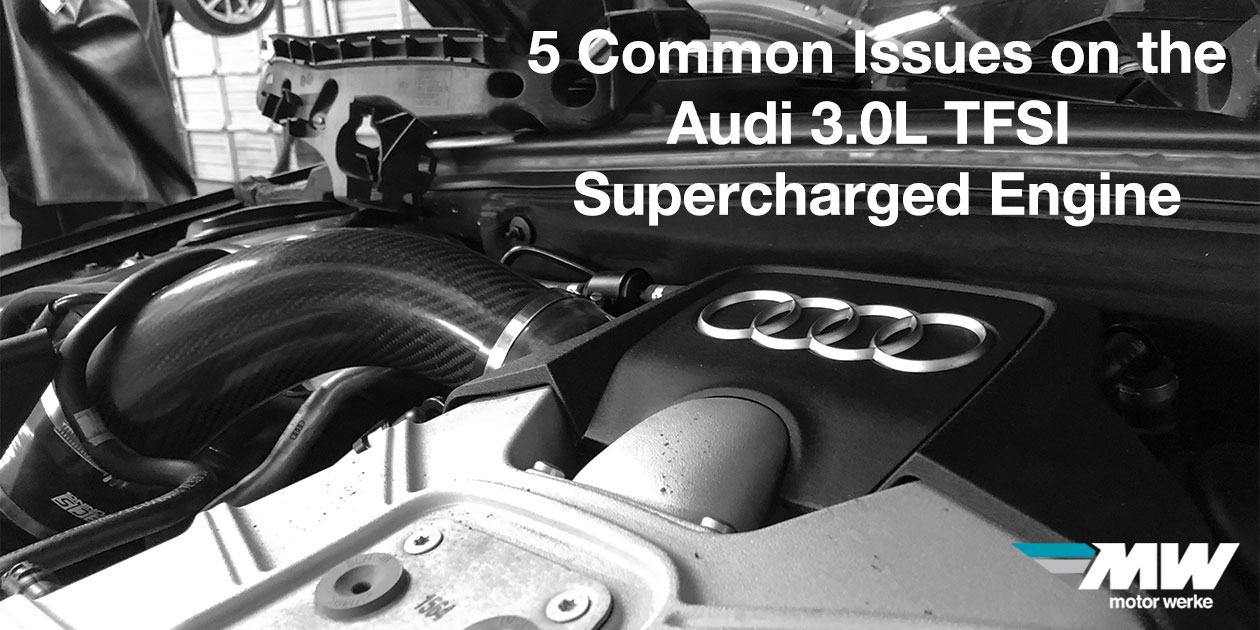5 Common Issues on the Audi 3.0L TFSI Supercharged Engine
Audi’s Supercharged 3-liter V6 engine was introduced in 2008 and has been a workhorse motor used in everything from the high-performance S4 and SQ5 to family haulers and large sedans like the Q7 and A6. With forced induction from a Roots-type supercharger, this engine is capable of some impressive power figures rivaling and outperforming V8s used in older Audi models. As far as Audi engines go, this one has been incredibly robust, with few major issues plaguing owners. That being said, there are five main issues this engine can run into, and we will be covering them here.
Coolant System
Some of the most common coolant leaks on the 3.0 TFSI happen at the water pump, thermostat, and around the coolant hoses under the intake. Hoses start to leak as the engine ages, and you may notice droplets of coolant in the engine bay depending on the severity of the leaks.
The air-to-water intercoolers that sit below the supercharger can also begin to leak. These leaks are typically slow, but as they get worse you will start to notice your coolant level dropping with no visible leaks. Once the leak reaches a certain point of severity, you may get a check engine light and notice your car running rough, indicating a misfire. Luckily, correcting this problem is relatively easy. The superchargers come off quickly, and the intercoolers themselves are not particularly expensive for an Audi part.
Upper Timing Covers
The timing system on the 3.0 TFSI is located at the rear of the engine. The covers protecting the top of the timing system have a tendency to leak oil.
When correcting a leaking upper timing cover, it’s best to replace both the gaskets and the covers themselves. Sometimes, removing the timing covers can distort them slightly, especially on older motors.
Crank Vent Valve
The crankcase vent valve is responsible for preventing excessive crankcase pressure. The valve sits under the supercharger, meaning the blower will need to be removed to perform the service.
The crankcase vent valve can fail in two ways. If it becomes stuck closed, the engine will build excessive pressure within the crankcase. This condition can cause a power reduction and may result in an engine seal blowing out due to excess pressure. If the diaphragm within the valve rips, the excess blow-by can trigger a lean code.
Carbon Buildup
The poor fuel quality in Canada contributes to more rapid carbon buildup. An engine choked by carbon will idle rough and feel down on power. In order to perform a carbon cleaning, the supercharger must come off. If you are getting your intercoolers or crank vent valve replaced, it’s a good idea to have the intake valves checked for carbon buildup.
Crank Damper Pulley
The front damper pulley reduces vibration and contributes to a smoother driving experience. The pulley uses rubber to deaden vibrations, and over time this rubber will blow out. When this happens, you will notice less smooth engine operation.
If you feel like your 3.0L TFSI Supercharged Audi needs some love, the team here at Motor Werke is here to help!
If you live near Kelowna and own an Audi with the 3.0 TFSI engine that needs service, schedule an appointment with Motor Werke today. Our experienced technicians have the skills to repair all of the most common issues these engines have.

